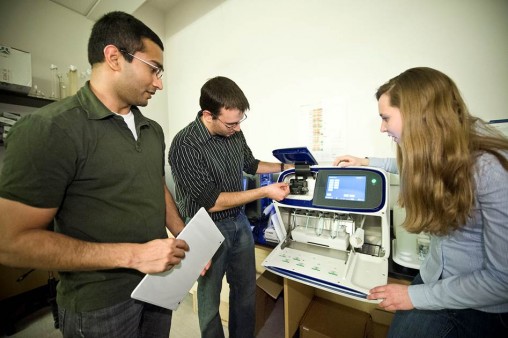
(L to R) Biomedical Sciences students Vijay Shankar, Richard Agans and Renee Albers work on an Ion Torrent Next Gen Sequencer. Biomedical Sciences was Wright State's first Ph.D. program.
They hold high-ranking faculty positions at major U.S. universities such as the University of California-San Francisco and Case Western Reserve. They populate industrial giants like Procter & Gamble and Eli Lilly. And they work in research labs at the National Institutes of Health and Centers for Disease Control.
They are among the 200 graduates of Wright State University’s Biomedical Sciences (BMS) Ph.D. Program. The campus community will be invited to celebrate that 200-graduate milestone in the fall.
“There are a number of great success stories,” said Gerald Alter, Ph.D., professor emeritus and former director of the BMS program. “This program has been a great partner in the growth of Wright State in providing opportunities for faculty and producing students we can be proud of.”
Biomedical Sciences—administered by the College of Science and Mathematics and largely populated by faculty of the Boonshoft School of Medicine—was established in the late 1970s as the first Ph.D. program at Wright State.
It attracted faculty in the biological sciences, basic science and what is now the Boonshoft School of Medicine. It grew to include faculty from engineering and other science departments.
Today, the program features about 100 faculty members from 12 different departments in four different colleges, local hospitals and Wright-Patterson Air Force Base. Approximately 65 students are in the program.
Graduate Ann Imber, Ph.D., a fourth-year medical student at the Boonshoft School of Medicine, said the BMS program was an outstanding opportunity for her to further her education in research.
“I am very grateful to have become involved in such a great program, and I look forward to continuing my career in medical research in the future,” Imber said.
The BMS program is divided into four areas of concentration—molecular genetics and cell biology; neuroscience and physiology; integrative biology; and structural and quantitative biology.
“While we have areas of specialty, we really have lots of interaction, synergism, that you might not find in a different program,” said Mill Miller Ph.D., current director of the BMS program.
The program features a number of cancer researchers, including one who discovered a DNA site where replication begins, a basis for understanding important biology. Other researchers work on recovery from traumatic nerve injury and on the science of handling large amounts of genetic information.
The program also features an impressive array of sophisticated high-tech equipment and robotics, mass spectrometers, nuclear magnetic resonance equipment, and electron and multi-photon confocal microscopes.
“We’ve got the whole toolbox needed to study biomedical problems,” Miller said.
BMS faculty recently purchased two Next Gen DNA Sequencers that determine the precise order of nucleotides in a DNA molecule within a matter of hours. A full microbial genome can be obtained in under two hours, the human genome can sequenced within a week, and both can be achieved inexpensively.
In contrast, Alter said, “The first human genome that was sequenced took about 15 years and hundreds of millions of dollars.”
Within weeks of its acquisition, one sequencer obtained data on all of the gene functions present in the human gut microbial communities.
Alter said Wright State’s BMS program is big enough to provide cutting-edge equipment and abilities, but small enough to provide a great deal of attention to students.
“The opportunities for getting trained in a very quality way are here,” he said.

 Wright State psychology team studies ways to identify fatigue in pilots, drivers
Wright State psychology team studies ways to identify fatigue in pilots, drivers  Wright State videographer Kris Sproles wins Regional Emmy and Ohio journalism award
Wright State videographer Kris Sproles wins Regional Emmy and Ohio journalism award  Wright State Boonshoft School of Medicine ranked among the nation’s best for 2024 by U.S. News
Wright State Boonshoft School of Medicine ranked among the nation’s best for 2024 by U.S. News  Exposing biotechnology
Exposing biotechnology  Wright State faculty member Dan Noel uses unique background to inspire new leaders
Wright State faculty member Dan Noel uses unique background to inspire new leaders 